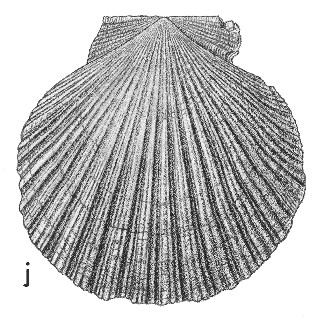
Revised descriptions of New Zealand Cenozoic Mollusca from Beu and Maxwell (1990)

 | Revised descriptions of New Zealand Cenozoic Mollusca from Beu and Maxwell (1990) | 
|
  (Pl. 38j): Rafa Downs, sea cliffs south of Conway River mouth, North Canterbury, Nukumaruan (GNS, from an old collection) |
Beu & Maxwell (1990): Chapter 15; p. 308; pl. 38 j.
Synonymy: Pecten delicatula Hutton 1873b, p. 30; Chlamys subantarctica Hedley 1916, p. 23; Chlamys campbellica Odhner 1924, p. 61; Chlamys instar Iredale 1925, p. 251; Chlamys titirangiensis Marwick 1928, p. 458; Chlamys delicatula; Chlamys (Zygochlamys) delicatula; Chlamys (sensu lato) patagonica delicatula, Beu & Maxwell 1990, p. 308, pl. 38j; Psychrochlamys delicatula, Jonkers 2003, p. 47
Classification: Pectinidae
Description: Much the largest Pliocene-Recent "Chlamys" of the New Zealand region (50-95 mm high), thick and solid; left valve slightly more inflated than right. Small specimens (to ca. 40 mm high) higher than long, obliquely extended postero-ventrally, with strongly unequal ears, and with ctenolium and large, functional byssal notch in right valve; changing with growth to free-lying, swimming adult with equidimensional disc (or length even exceeding height in some large shells) and much more nearly equal ears, with byssal notch shallow and not functional. Radial costae 22 to 34, narrow to moderately wide, of low triangular section; initially simple and almost smooth, but increasing in number by both subdividing (symmetrically, in most specimens, each major costa having a secondary costa on each side) and intercalation of fine tertiary and quaternary costellae; all bearing scale-like spines where crossed by fine commarginal lamellae.
Comparison: Zygochlamys delicatula differs only in its narrower costae, differently shaped ears, and paler coloration from the southern South American species Z. patagonica (King & Broderip) (late Pliocene ?; Pleistocene-Recent). Ancestral forms in New Zealand are Z. seymouri (early Opoitian, Momoe-a-Toa shellbed, Chatham Island), with narrower radial costae and a functional byssus in adults, and Z. whenuataruensis (Jonkers, 2003) (Whenuataru Tuff, Pitt I., Chatham Islands, Waipipian), which is intermediate between Z. seymouri and Z. delicatula but has unique, large, spine-like scales on the radial costae. [See Fleming 1944; Beu 1985a; Beu 1995; Jonkers 2003]. Jonkers (2003) transferred all these species to his new genus Psychrochlamys, but we agree with Dijkstra & Marshall (2008, p. 63) thst this is part of the same clade as Zygochlamys.
Distribution: Earliest Nukumaruan-Recent. Castlepoint, eastern Wairarapa, Nukumaruan (type of Pecten delicatula); Macquarie Island, subantarctic, Recent (type of Chlamys subantarctica); Campbell Island, Recent (type of Chlamys cambellica); southern Tasmania, late Pleistocene (type of Chlamys instar); Titirangi Sand (Nukumaruan), Titirangi, Chatham Island (type of Chlamys titrangiensis). Early Nukumaruan at many localities throughout Wanganui basin (Hautawa Shellbed), central Hawke's Bay to South Wairarapa, and in Marlborough and North Canterbury; in the Ohara depression, on the summits of Mts Kohinga and Miroroa, Napier-Taihape Road, and on the crest of the Ruahine Range, inland Hawke's Bay (Beu et al. 1977, 1981); one locality (1 immature valve) of Castlecliffian age: Mendip Hills station, Leader River, Parnassus area, North Canterbury (with Pecten novaezelandiae); also common in late Pleistocene (20 000 yrs) concretions trawled in Cook Strait (Fleming & Boreham in Pantin 1975); a few specimens in concretions and loose on the seabed off western Northland and off the Three Kings Islands, probably Pleistocene (Beu 1999). Only a few specimens have been collected off southeastern Australia (SE Tasmania and E Bass Strait) and all are empty shells, so this apparently was a brief Pleistocene range extension only. Living at present abundantly from Macquarie Island and the other New Zealand subantarctic islands to as far north as Otago Peninsula (mostly in more than 400 m, a few specimens as shallow as 70 m), where it is common enough to be fished commercially, and in equally deep water in Pagasus Canyon, North Canterbury; rarely alive as far north as Cook Strait.
Cite this publication as: "A.G. Beu and J.I. Raine (2009). Revised
descriptions of New Zealand Cenozoic Mollusca from Beu and Maxwell (1990). GNS
Science miscellaneous series no. 27."
© GNS Science, 2009
ISBN
978-0-478-19705-1
ISSN 1177-2441
(Included with a PDF facsimile file
copy of New Zealand Geological Survey Paleontological Bulletin 58 in CD version
from: Publications Officer, GNS Science, P.O. Box 30368 Lower Hutt, New
Zealand)